
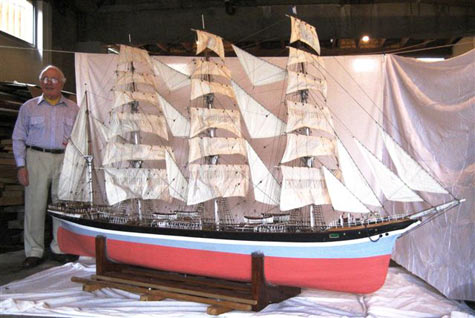
Ian Hunt and his completed model
Because of the passage of time and the `passings’ of people, many may not remember the story of the Sindia but others may have read about it on various websites, that fascinating story of the 329 foot, steel-hulled, four-masted sailing barque which ran aground in the very early hours of December 15th 1901 a mere 150 yards from the beach of Ocean City, New Jersey in the United States.
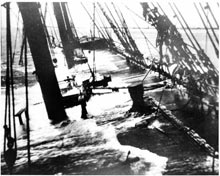 |
Decks awash, the Sindia went down 150 yards off the beach at Ocean City, New Jersey
click thumbnails to enlarge |
She was travelling from Japan headed for New York and sailing off the New Jersey coast under full canvas when she came to sudden rest in the sand after losing her way in a storm. Over the years that followed the wreck of the Sindia sank deeper and deeper into the sand and water and several attempts to recover her failed. In 1969, the wreck and the area in which she lay was designated as an official historical site by the State of New Jersey.
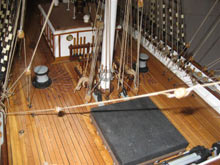
|
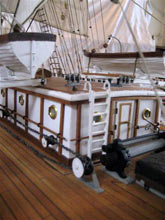 |
| Details around main hatch including fife rails and rack for capstan bars |
Detail on main deck house |
You would think that there would be several scale models around of the ill-fated ship, but aside from one in the Ocean City Historical Museum in New Jersey I can find no other, that is `other than the one created over a period of 14 years in Sydney, Australia by my perfectionist friend and skilled model shipwright, Ian Hunt which this article is about. It is a model of immense size and incredible almost unbelievable detail and is perhaps the finest one ever made of this vessel, or for that matter ever likely to be made.

Nine thousand, two hundred and six hours went into the making of this 10’ 6” (or 3.2m) model, at the time of photography leaving only the keel to be attached before an October one-off launching and embracing by the water.
This Sindia without her detachable sailing keel is 91lbs (40 kilos), a substantial weight and you would hardly take her overseas on an aeroplane as excess baggage! (In fact, getting the model into a truck for transport to the launching site may require a mechanical hoist unless there are helpers each not in any way concerned about getting a hernia!)
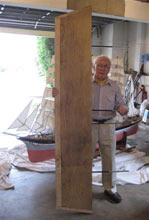 |
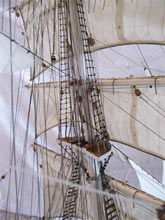 |
| Ian with slab of wood to make the huge sailing keel |
Sail and rigging detail aloft. |
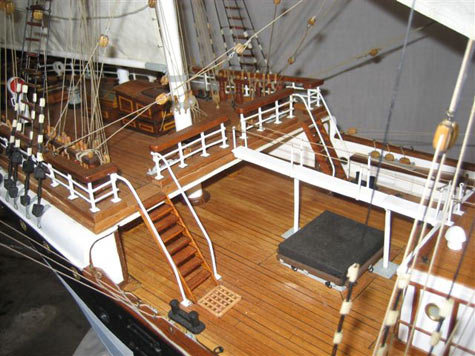
The walkway giving access to the spare binnacle on roof of aft deckhouse
I have the first photograph sent to me by Ian of him standing by the hull and holding it towards the sky – was that a sign of `high’ expectations I wondered at the time, or some private signal that the builder considered that the build would be a very tall upward (and `lengthy’) task?
The hull is built with 28 frames, 16 stringers plus three watertight bulkheads that divide it into 5 separate compartments. I think that Ian may have wanted to ensure that no damn sandbank or rising tide was ever going to sink his Sindia. (I reflect on the weight of the model here and use the rather crude Kiwi saying, `built like a brick sh/* house’ but in the case of Ian Hunt’s square-rigger she is far from that and is…instead a `ship house’ of great beauty).

Detail around the base of the foremast, looking foreward tp the break of the fo'c'le with the anchor winch just visible underneath it.
The model’s hull is planked with 480 feet (146m) of 3/16” kauri pine and decked 369 feet (121m) of kauri planking laid on a 1/16” waterfroof ply deck. The patience, skill, a steady hand and good eyesight needed in the construction by Ian I believe needs stressing. On the patience side there is the time taken before the model would be completed, the steady hand requirement does not need explaining but can be linked to the highly intricate work such as the 234 belaying pins, each one lathe-turned from standard pop rivets and filed to shape, and the attaching of the ship’s ratlines to the shrouds requiring 1,510 clove hitches that needed two pairs of tweezers plus a magnifier!
I’d like to add that each of the Sindia’s four lifeboats are built exactly like the original, clinker planked, internally each one fitted with stringers, frames, thwarts, hooks, knees and spreaders, each boat with six hand-shaped oars, one slightly longer steering oars, rudder and separate tiller, mast, rope and a wooden bailer - and they float and sail The photograph shows the detail.
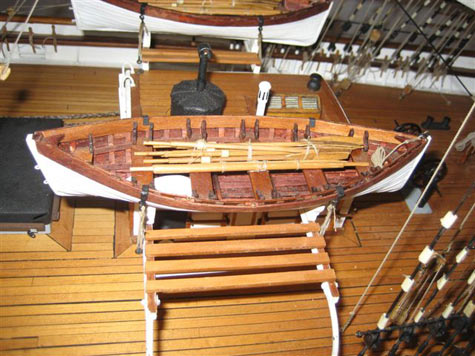
The ships boats on the skids amidships with all their gear stowed neatly inside. Each boat floats and is really a model in its own right.
There is so much more, like the brass anchors that can be dropped using the anchor release gear, the deck-mounted cargo winches with 105 similar parts (and there are three of them!), the anchor windlass buried below the foredeck and with 84 separate components that took three months to build, and the complicated Harland & Wolff patent design rigging screws and chainplates that attach the rigging to the hull, 96 of them in total.
I must bow out now and leave it to publications like Ships in Scale and perhaps Model Shipwright to delve deeper into the countless other areas of facts and figures and fascinating details that I haven’t the space to cover nor the engineering savvy to either comprehend or explain.
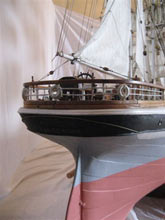 |
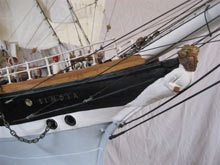
|
| Stern detail including the taffrail around the poop, steering wheel and stern carvings. Note `in and out' strakes of hull plating. |
The figurehead - the Sindia himself (an 18th century Indian Prince) and other detail around the bows including the stud-link anchor chain. |

Suffice to say that in my humble opinion, this one, absolutely magnificent, hand-built-by-one-man scale model of the Harland & Wolff built barque Sindia represents an achievement par excellence in the world of model shipbuilding where good things take time and all the other attributes needed by the model shipwrights on this planet of ours. Ian Hunt, I am impressed beyond belief, I am proud to be your friend and I salute your achievement
To go into the full details surrounding the building of the boat would require me to write an entire book which for a non technical writer like myself would probably drive me insane. I chance my arm in saying that neither my old friend Ian nor his dear wife, Ruth, nor Tony his son would get pleasure out of seeing that happen!
***** |

